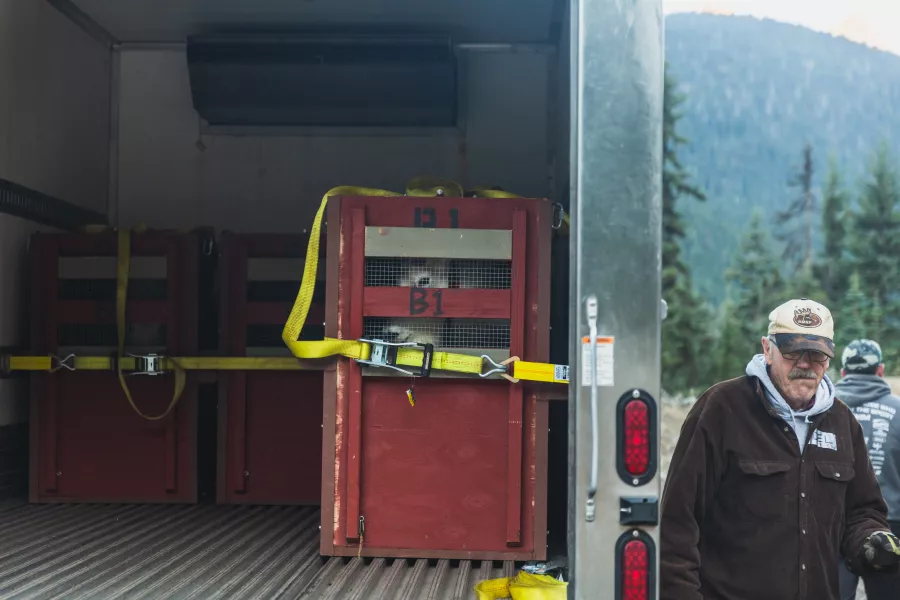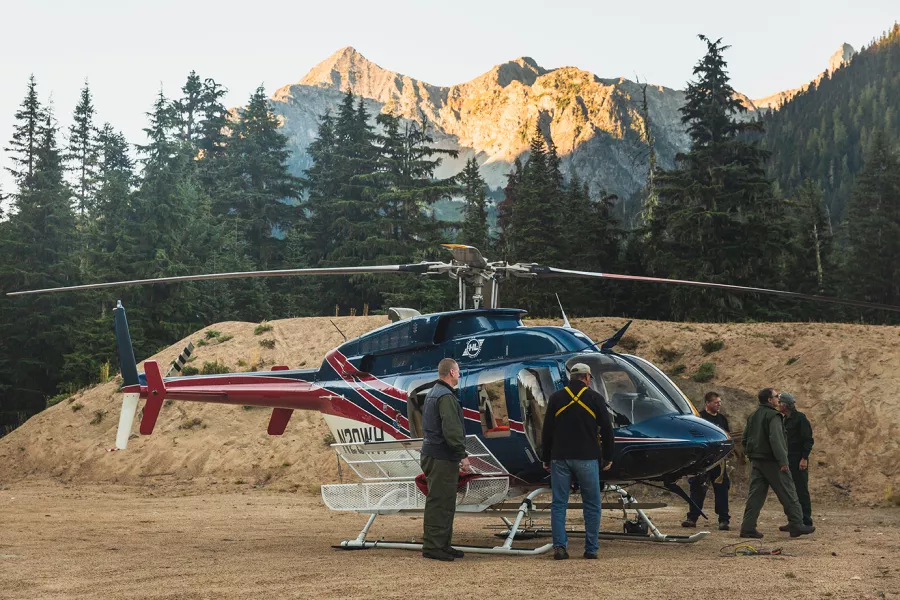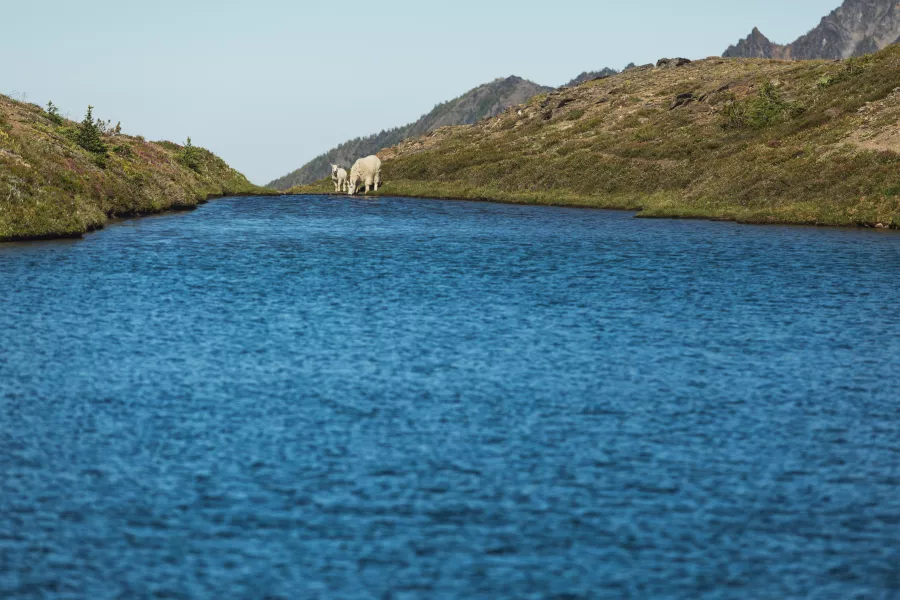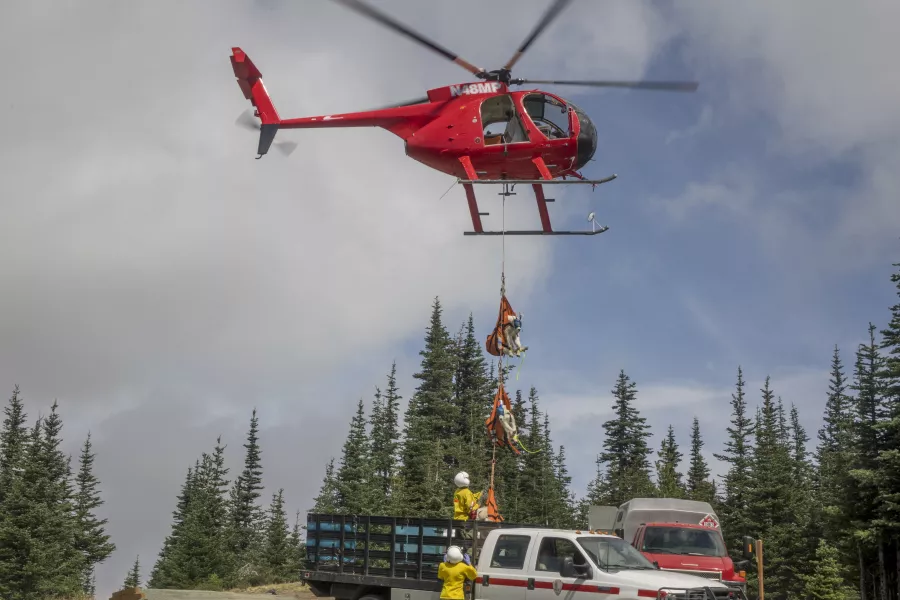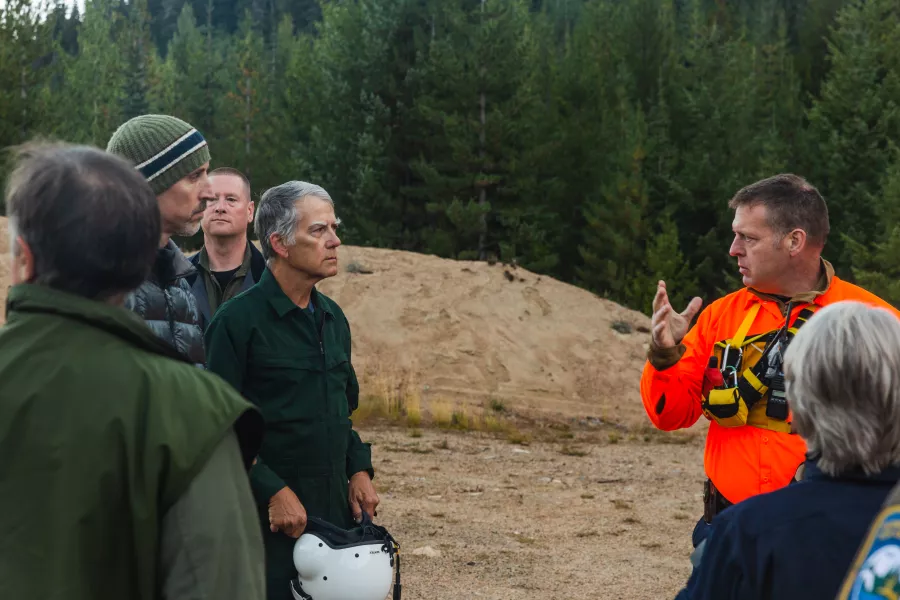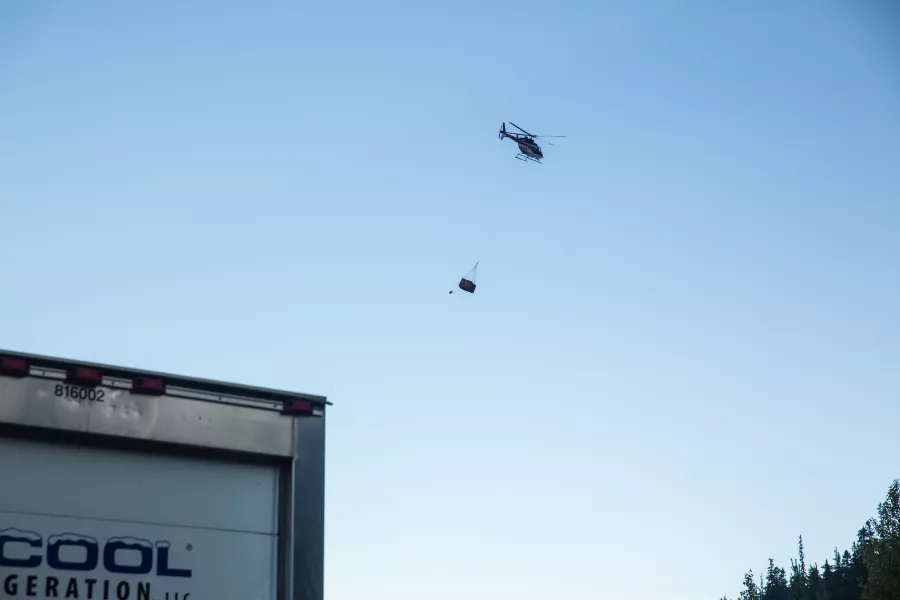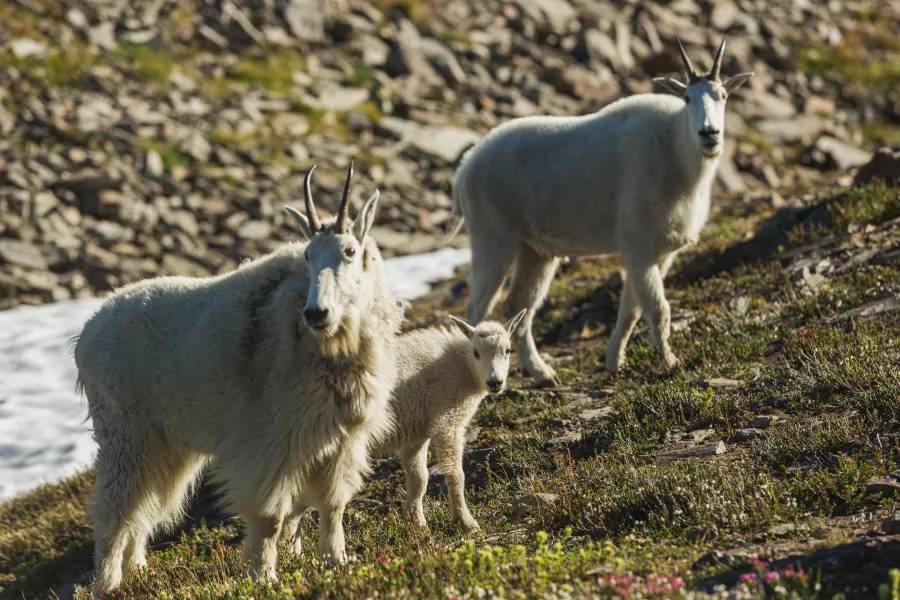Mountain goats are at a crossroads in Washington state.
On one side of Puget Sound in the Olympic Mountains, mountain goats are viewed as an introduced, nuisance species threatening to overrun the national park while devastating a fragile alpine ecosystem that was never meant to support them.
Across the sound in the Cascades, mountain goats are lonely. The natural populations of the iconic mammals continue to dwindle in high alpine regions that have historically supported them.
State and federal officials from the National Park Service, National Forest Service, and Washington Department of Fish & Wildlife all agree: There are too many goats in the Olympics and not enough goats in the Cascades.
Attempting to solve this conundrum requires helicopters, refrigerated trucks, veterinarians, wildlife scientists and technicians, tribal members, community volunteers, thousands of hours of work across agencies, many goat-sized blindfolds and, of course, Western: specifically, Professor of Environmental Science David Wallin and his students.
Wallin has studied the problems with the Cascades’ goat populations for more than a decade, and says that due to a variety of reasons, from hunting to erosion of their winter habitat, mountain goat populations in the Cascades declined for most of the 20th century. Hunting pressure was reduced in the 1980s after the state slashed the number of hunting permits, and since then, two of the main herds in the Cascades—the Mount Baker group and the group in the Goat Rocks Wilderness Area between Mount Rainier and Mount St. Helens—appear to have recovered and now are relatively stable.
Less hunting pressure hasn’t, however, helped goat populations recover in areas such as the mountains near Darrington, which once held thriving goat herds. Moreover, genetic analysis of goats throughout the Cascades indicates the goats aren’t moving around very much, especially between populations in the north and south. This limited movement can lead to a loss of genetic diversity and reduced survivorship.
“People tend to think, ‘How can goats be in trouble? All the alpine habitat is protected,’ and that’s true for half the year, when they are in the high alpine zones,” Wallin says. “But the other half of the year, they come down into valleys that are much more developed.
“But the biggest factor leading to isolation of mountain goat populations in the Cascades is that I-90 basically walls them off from each other,” he says. “Because the two small groups are so isolated physically and genetically, it makes them much, much more vulnerable.”
Goats that can interbreed, like the large herds in British Columbia’s Coast Range, are 15 percent more likely to live until their second year. That’s a big edge considering that a hunting harvest of just 1 percent can cripple a herd’s overall survivability rate.
“The goats that were introduced into the Olympics in the 1920s by hunting clubs are different genetically than those in the Cascades; they came from places like the northern Rockies in B.C. and from Southeast Alaska,” Wallin says. “An early effort at translocating goats in the 1980s brought some of these goats over to the Cascades, and we can still see the influence of their DNA on some of the groups of the Cascades goats today.”
So while adding goats from the Olympics is important to bump up the population in the Cascades—which has dropped from about 10,000 animals to roughly 3,000—just as important is the introduction of much-needed new genetic material.
Even with local tribes, higher education, and state and federal agencies behind the project, the goats weren’t going to trot down to Port Townsend, take the ferry and head up into the Cascades on their own. Getting them into alpine zones half a state away is a massive undertaking; state and federal officials wanted to move between 300 and 400 goats over three summers from the Olympics to the Cascades.
Call in the ‘goat muggers’
It’s a little after midnight high up along the Cascade crest, about 10 miles west of Washington Pass along the North Cascades Highway; a panoply of stars blankets a cloudless night sky and the Milky Way arcs between two backlit peaks in a breathtaking swath of million-year-old light.
Two refrigerated box trucks chug slowly up a dirt road to a Department of Transportation gravel and sand pit, and their arrival triggers half a dozen sleepy inhabitants to roll out of their tents or hammocks.
The goats have arrived.
In the back of the two trucks are bright red crates, each with a bill of lading describing the crate’s contents: “Nanny, 91 pounds.” (in goat parlance, a billy is a mature male, a nanny is a mature female, and kids are young immature goats). Staring out placidly from her crate is one of the hundreds of goats to be moved in the last two summers. She blinks calmly at the faces that appear in front of her; she’s been sedated for the past 12 hours.
Even in their crates, Oreamnos americanus are impressive animals; two long, sharp, slightly curved horns perch atop a proud forehead, and even in midsummer it is easy to see how their dense, snow-white coats can protect them in temperatures as low as 50 degrees below zero and in winds reaching 100 miles per hour.
More than a dozen goats are in these crates in the two trucks, and after a brief inspection, the back doors to the trucks are rolled closed and the refrigeration turned back on to keep the goats cool. Wallin performs a perfunctory check and then returns to his sleeping bag, waiting for the dawn and the last phase of the goats’ journey.
The day before, these goats had been on a mountainside in the Olympics before a complex chain of events ended with them in this gravel pit in the middle of the night. The process of finding and securing goats in the Olympics is arduous, and not without risk to both goat and its human would-be benefactors.
First, searchers spot the goats from helicopter, then the goat is either shot with a tranquilizer dart or entangled in a special kind of net shot from a gun. The helicopter hovers near the immobilized goat and the “goat mugger” leaps out. The goat is blindfolded, its horns are wrapped in Styrofoam, its legs are bound so it won’t thrash, and then it is wrapped in a sling and slowly airlifted down to the Olympics staging area, where veterinarians and scientists are waiting.
At the staging area, the goat is checked to make sure it is doing well, then its vitals are recorded and its DNA sampled. Some are outfitted with GPS collars to assist in tracking them in the years to come, a summer job undertaken by a group of Wallin’s students.
Finally, the goat is unbound, its blindfold removed and it is loaded into the crate while it is still woozy. Over the past two summers, nearly 300 goats have been moved from west to east, with one more summer of translocation to go. These are the lucky ones; any goats left after next summer in the Olympics will be killed.
The goats of the Olympics, much to the consternation of wildlife biologists, have been trampling and eating their way into the proverbial doghouse for years. Ranging far across the area, they have proven to be quite adept at destroying fragile alpine environments that were never designed to support or tolerate them. And in their endless search to satisfy their need for salt, they have begun to frequent campgrounds and popular trails, attracted to the urine left behind by campers and hikers.
Tragically, in what ended up being the last straw, an angry goat fatally gored a 63-year-old hiker on a trail in the Olympic National Park in 2010.
Freedom
As the first rays of the morning sun began to set alight the peaks of Liberty Bell Mountain and Early Winters Spire just to the east, the camp again rouses from its slumber, and shortly afterward, the helicopter and its ground crew arrive.
The goat wranglers, including WWU students Nick Andrews and Naryan Dahlstrom, get a quick crash course from the ground crew on how the crates are lashed together while the team made up of Wallin and state and federal scientists is helicoptered to the release point high above the valley. Dahlstrom said this kind of work was incredibly valuable moving forward after graduation and into his career.
“I’m actually looking to get into wildlife rehabilitation, so having this kind of experience really looks good if I want to get into that line of work,” he says.
Andrews agreed.
“I’m really interested in wildlife management and that side of environmental science, so this is right up my alley,” he says. “And having faculty like we have who work so hard to (be) so inclusive to the undergrads for opportunities like this is really, really cool.”
The helicopter arrives back at camp, hovering over the first set of three goat crates triple-lashed together. The ground crew connects the helicopter cable to the crates and the goats rise into the air on the final leg of their journey to the Cascades. The ferrying from the gravel pit continues all morning until the last load is delivered at the mountaintop.
At the release point, Wallin releases a nanny goat and her kid from the crates. They sprint woozily down the hillside, then turn around for a last look at the release team before disappearing over a rocky knoll and into the heart of the wild Cascade crest.
Imprinted in their cellular data is a DNA lifeline for the Cascades goat herds, and years of monitoring lie ahead for Wallin, his students, the agencies and tribes to see if that lifeline can bear fruit and help the Cascades herds rebound.
“We know these translocation efforts can work,” Wallin says. “And after three summers and about 300 goats, we will have certainly given it our best shot.”
